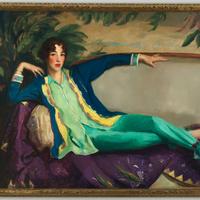More about Robert Henri
Works by Robert Henri

Sr. Editor
Robert Henri is best known as the leader of the Ashcan school, a politically minded group of artists who were passionate about portraying the realities of American life - grittiness and all.
Born in Cincinnati, Ohio, Henri had a somewhat tumultuous upbringing that was shrouded in secrecy until many years after his death. In fact, there seemed to be no record of the Henri family at all. As it turns out, the artist’s family changed their surname after an incident in which Henri’s father fatally shot a cattleman in an altercation. Though he was later cleared of a murder charge, the family moved to Denver, and later Atlantic City, and thought it best to change everyone’s names in case the scandal ever caught up with them. Henri’s father was, originally, John Jackson Cozad, and Henri was born Robert Henry Cozad. His parents adapted his middle name to pay respect to their French heritage, but Henri found the French pronunciation pretentious, and insisted upon “hen rye.”
Henri’s mother, Theresa, instilled in young Robert a love for learning and culture, and he was known to draw in the margins of his homework from a young age. His artistic education continued in Philadelphia, where he studied at the Pennsylvania Academy of Fine Arts under Thomas Eakins. A couple years later he traveled to Paris and studied under realist painter William-Adolphe Bouguereau, became enchanted with the work of Francois Millet, and also the Impressionists (though that was an infatuation that would not last long).
Henri, who had grown up in the country and was no stranger to hard work, began to feel disillusioned with the bourgeois art world. He was determined to find a new style of painting that better reflected the experience of the working class in the wake of the Industrial Revolution. Having worked as illustrators for newspapers, Henri and his friends approached artmaking more from the perspective of investigative journalism, rather than simply making pretty pictures. The name “Ashcan school”, like the Fauvists, originated from what was meant to be a critique of their work. A staff member at the socialist publication the men drew for, The Masses, complained that they were publishing “too many pictures of ashcans.” It was meant as a criticism of their choice of subject matter - dirty city streets and the struggles of the poor - but the men loved it, and adopted Ashcan as the name for their group.
Aside from his accomplishments as an artist in his own right, Henri is also remembered for his illustrious career as an educator. His theories and attitude towards art (rather than his direct style) influenced students who would go on to have great success, like George Bellows and Edward Hopper, who both focused on everyday American life as their subject matter. Henri has also been praised for his mentorship of women students, many of whom went on to make significant contributions to American modernism (though they have only begun to be acknowledged more recently thanks to the efforts of feminist art historians). Henri urged all his students to paint what they know and embrace their individual style, which was a thoroughly modern attitude for the time.
As for his personal life, Henri was married twice. His first wife Linda Craige, originally a student of his, died after only 7 years of marriage, having long been in poor health. Linda’s death devastated Henri, who threw himself into his work and sought comfort in the company of his circle of friends in New York. Three years later, Henri met Marjorie Organ, a young artist working as a cartoonist who one biographer described as “a beautiful, vivacious redhead.” As for her part, Organ was purportedly attracted to Henri’s “slight southern drawl and electric changes in manner.” They had a quick and fairly secret courtship before quietly getting married in a civil ceremony with no guests and, more importantly, no reporters. His portrait of her, The Masquerade Dress at the Metropolitan Museum of Art, is one of his most famous works.
Henri died of cardiac arrest, a complication resulting from prostate cancer in 1929 at the age of 64.
Sources
- Anania, Billy, “The Ashcan School painted the American working class,” Jacobin Magazine, August 11, 2021. Accessed August 19, 2021. https://jacobinmag.com/2021/08/ashcan-school-new-york-city-art-world-am…
- Homer, William Innes. Robert Henri and His Circle. New York, NY: Hacker Art Books, 1988.
- Wardle, Marian. “Thoroughly modern: the ‘New Women’ art students of Robert Henri,” American Women Modernists: The Legacy of Robert Henri, 1910-1945. Edited by Marian Wardle. New Brunswick: Brigham Young University Museum of Art, 2005.
- Weinberg, H. Barbara, Bolger, Doreen, Curry, David Park. American Impressionism and Realism. New York, NY: The Metropolitan Museum of Art, 1994.
Featured Content
Here is what Wikipedia says about Robert Henri
Robert Henri (/ˈhɛnraɪ/; June 24, 1865 – July 12, 1929) was an American painter and teacher.
As a young man, he studied in Paris, where he identified strongly with the Impressionists, and determined to lead an even more dramatic revolt against American academic art, as reflected by the conservative National Academy of Design. Together with a small team of enthusiastic followers, he pioneered the Ashcan School of American realism, depicting urban life in an uncompromisingly brutalist style. By the time of the Armory Show, America's first large-scale introduction to European Modernism (1913), Henri was mindful that his own representational technique was being made to look dated by new movements such as Cubism, though he was still ready to champion avant-garde painters such as Henri Matisse and Max Weber.
In 1929 Henri was named as one of the top three living American artists by the Arts Council of New York.
Check out the full Wikipedia article about Robert Henri











